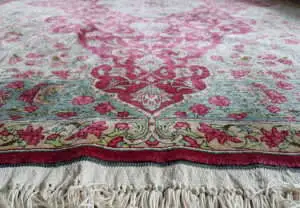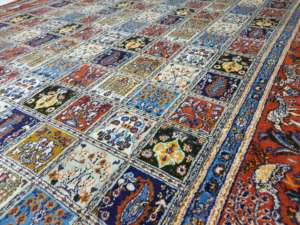Carpet & rug history -originally carpet history was taken extremely seriously.
With people documenting early production and even going on to write books on the subject.
As early as 1934 publications such as The History of British Carpets proved to be popular in its day with a further publication in 1966.
Rugs often told a story. Carefully woven sometimes depicting wars or kings & Queens for example.
Mass produced carpets / rugs required large investment and plant. Which in turn saw the requirement of vast buildings to work in.
To say its been a ‘roller coaster ride’ for the industry is an understatement.
From boom to almost bust as people’s taste and preferences changed over the years.
Long established areas of carpet & rug manufacturing have seen big mills turned into shopping arcades or car parks and even housing estates.
Some of the road names pay tribute to early manufacturing / trading names that include carpet & rug in their titles.
If you head North towards Yorkshire and head to Halifax you may find Dean Clough Mills once the powerhouse of carpet manufacture.
John Crossley & Sons made carpets from the mid 1820’s keeping the machinery working over 24 hour periods to maximise carpet production.
Visit today and you will find the building (once bustling environment ) has been re used as a heritage centre.
Its not all bad news though – Brinton carpets (established in 1783) are still manufacturing in Kidderminster. Brinton’s have manufactured carpets for most of the Royal Family and many other high profile customers.

Tomkinsons are also a well established carpet manufacturer who in the 1870’s were the first in England to use the steam powered Axminster loom.
Rug and carpet origins – where did it all start?
Around 1000 years BC in Asia Minor Genghis Khan championed early rug making in the Mongolian Empire.
The oldest carpet recorded is the world famous Pazyryk carpet that is around two metres square. It would be known as a Persian carpet these days.
This rug was unusual in that it was made using a Turkish Knot, this points to Anatolian origins.
The carpet was found in 1949 by a Russian archaeologist excavating a site in Pazyryk valley of Southern Siberia.
The Mongolians have adopted various Scythian traits. The love of horses, effective combat skills and a passion for high quality / treasured items.
A finely crafted carpet / rug would often be placed in a tomb of fallen warriors and leaders of the day. A tradition still followed today.
Carpet & rug history discovered and documented for our information today.
Carpet & rug traders in the 17th century.
By the early 17th century carpet & rug weaving was prevalent across the majority of the Indian sub continent.
The East India Company had established trade links in the area at this time, sending thousands of fine quality rugs back to newly built shops in the big cities in England & Scotland.
The latter part of the 19th Century saw the British Empire take control of large areas of production in India.
This opened doors for enterprising British businesses that opened factories producing fine rugs that were shipped back to the UK.

Antique carpet & rug cleaning.
If you own a antique or vintage rug fear not.
We recently cleaned a 250 year old area rug that was discovered blocked up behind a wall in a Scottish castle.
Careful rug preparation took place, we lightly tested the fibres for colour bleed before cleaning started.
We vacuumed with a high brush setting on our Sebo BS 36 Comfort, this used a lighter beating motion on the fibres.
Results were astonishing. Colours sprang to life again and looked as they did two and a half centuries before.
Our customer was extremely happy with the rug cleaning results although admitted to being nervous before!
If you have a vintage or antique rug that you are concerned about we are happy to discuss any concerns that you may have relating to careful cleaning.
Brighton 634177 or Eastbourne 520044.


